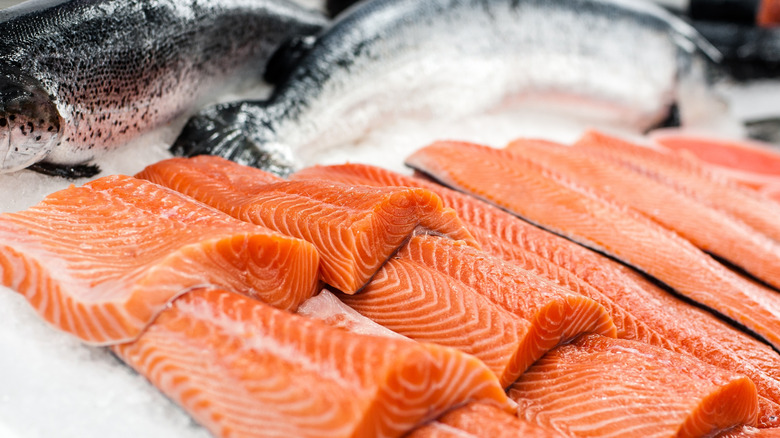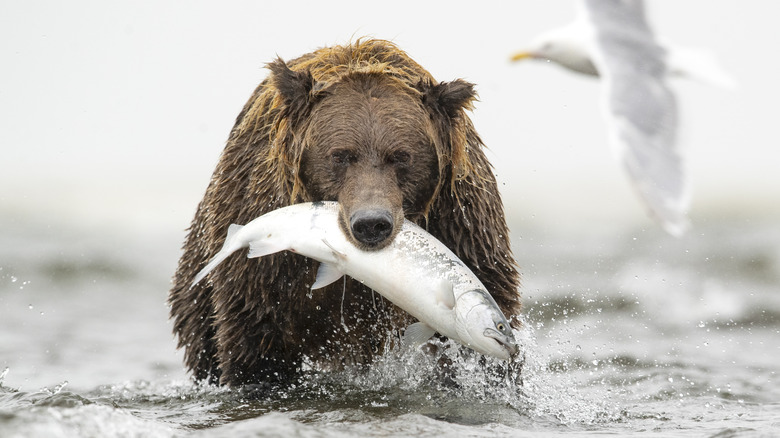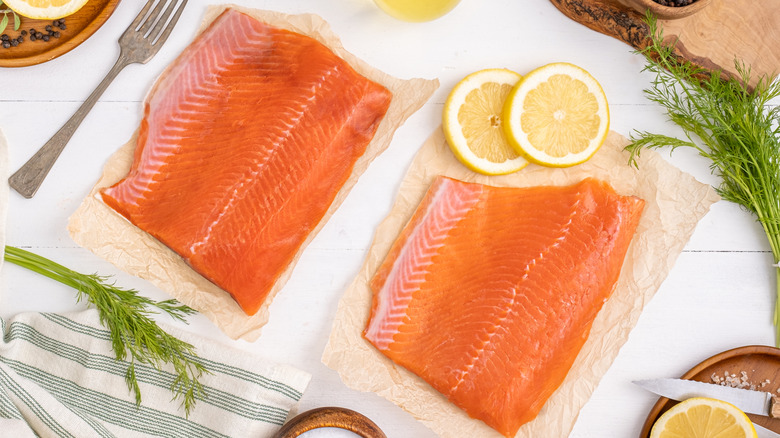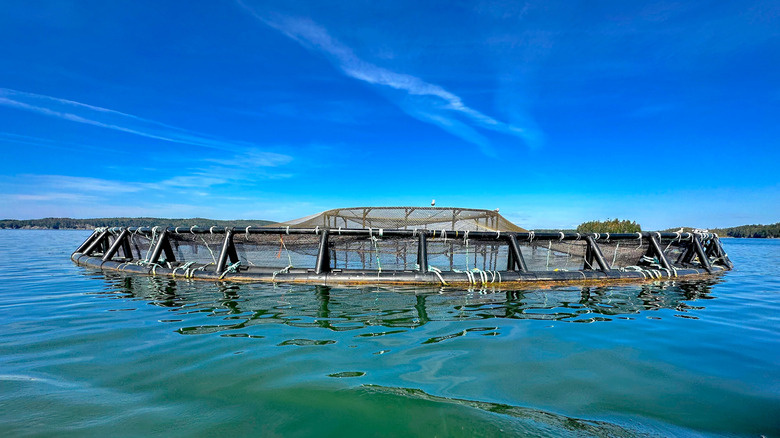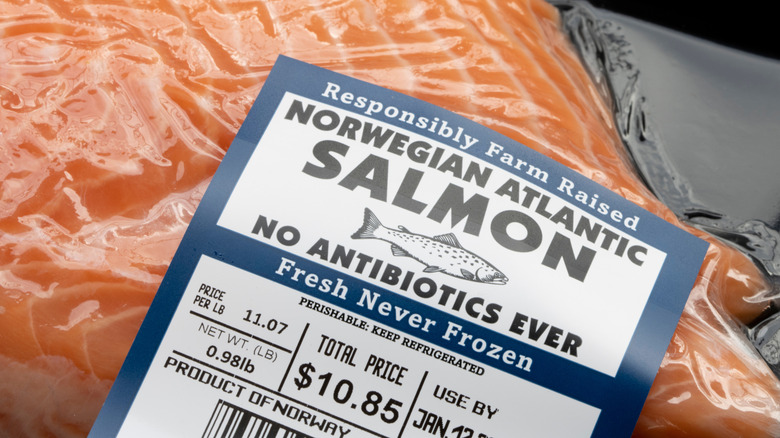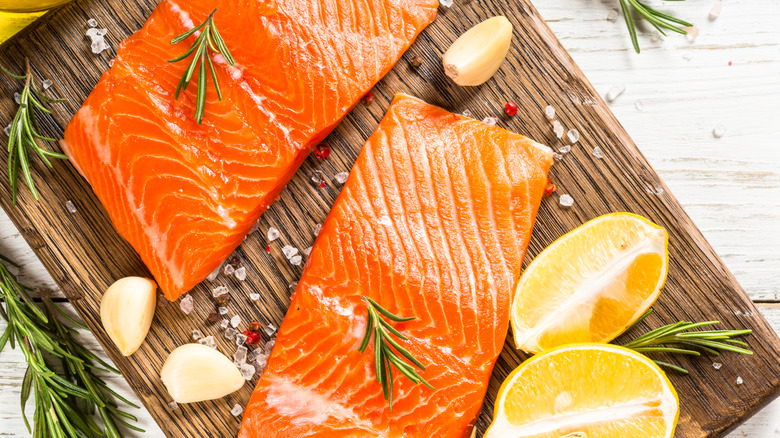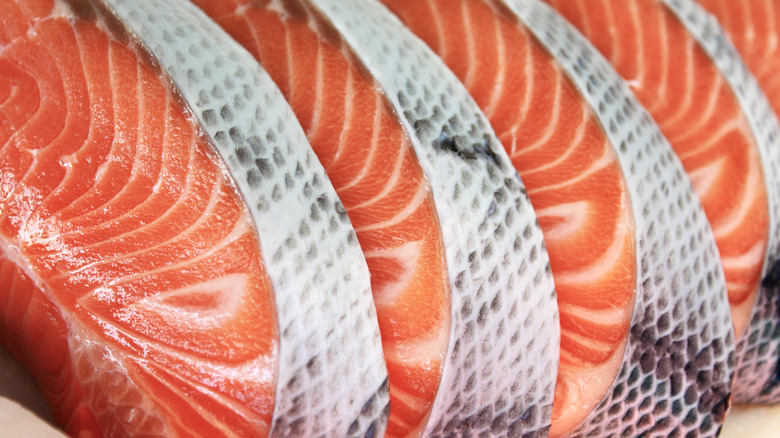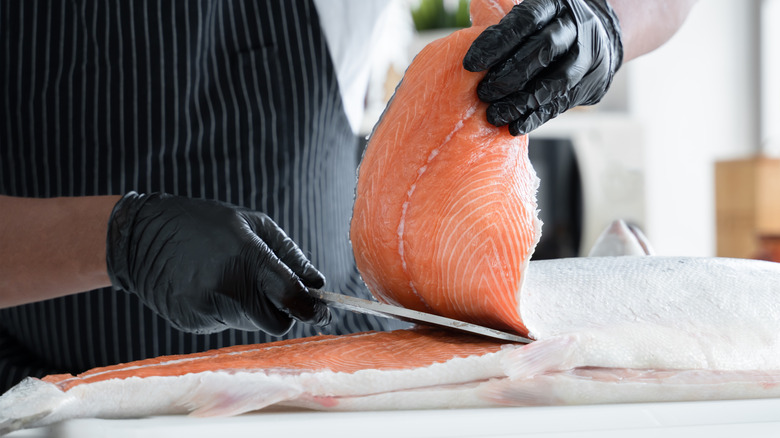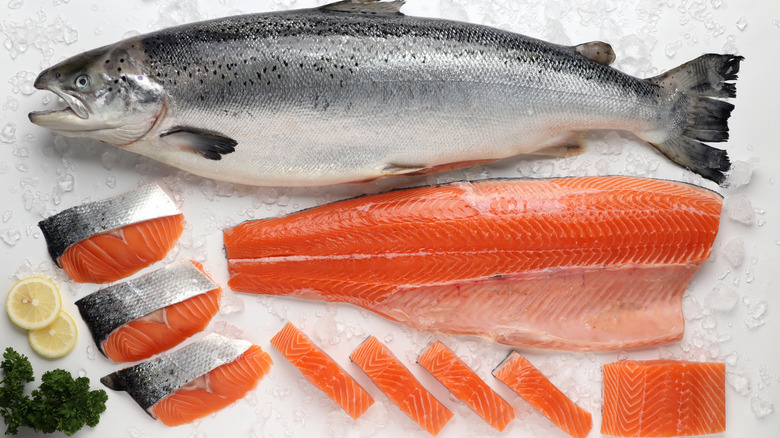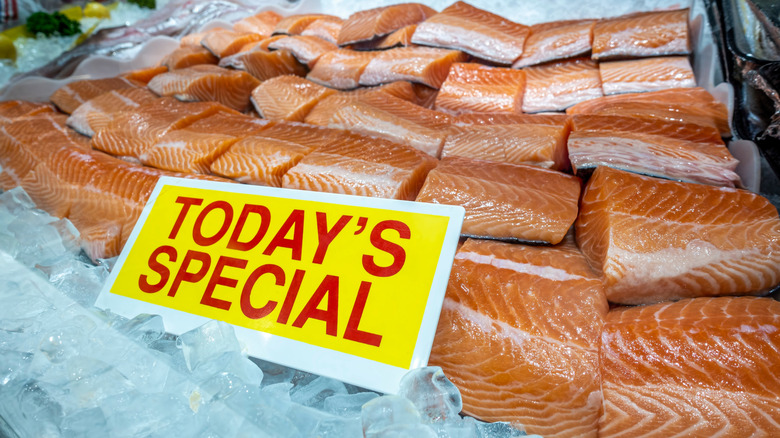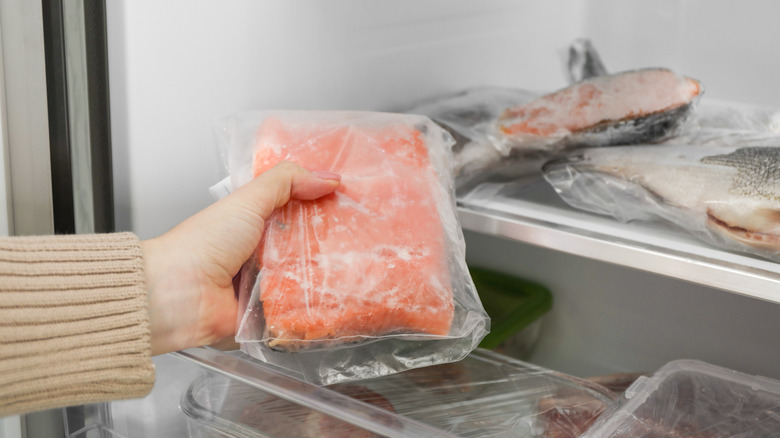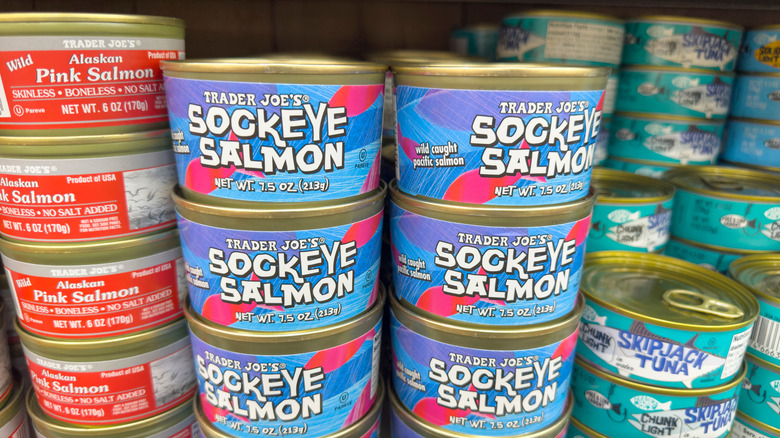12 Things Experts Say You Should Look For When Buying Salmon
We may receive a commission on purchases made from links.
The West eats cod, the East eats mackerel, and everyone eats salmon. This is an old saying in the seafood industry, but it's deliciously true. Salmon frequently ranks among the most consumed seafood in the U.S., and its popularity continues to climb. On average, Americans eat over three pounds of salmon per person every year.
And what's not to love about it? Salmon is widely available, super versatile, and a good source of healthy omega-3 fatty acids, protein, vitamin B12, potassium, and other nutrients. With all this in mind, it's easy to feel good about salmon that comes from a restaurant or a fancy fish market — but shopping for fillets at the grocery store is another story. Is farmed salmon bad? Is wild salmon fishy? How do I know if my salmon is fresh?
To cut through the uncertainty, we turned to a few salmon experts for advice. Scott Kohno is a sushi authority and owner of Yama Sushi Marketplace in California; Allie Hagerty is the recipe creator for Seasoned & Salted, and the daughter of Marty Hagerty, a longtime fishmonger at Fresh Pond Seafood near Boston; Adam Witt is a cook, video creator, and Bluehouse Salmon aficionado; and chef Maricel Gentile is the owner of Maricel's Kitchen, the author of "Maricel's Simply Asian Cookbook," and a proponent of sustainable seafood-industry practices. These experts agree that you can find good salmon at the grocery store — you just have to know what to look for.
Wild-caught salmon (in season)
If you're looking for the pinnacle of quality, buy and enjoy your fish during wild salmon season. "Wild-caught salmon has that rich, deep flavor — it's what I grew up eating," says the fishmonger's daughter, Allie Hagerty. "If you're buying wild-caught, peak summer is when it shines." In the U.S., that's typically May to September. During this time, you'll find the widest, freshest selection of wild salmon from the ocean and inland waterways of the Pacific Northwest.
Some of the most coveted wild salmon varieties (king, sockeye, and coho) are found in the icy Copper River of Alaska. Every year, these fish swim an astounding 300 miles upstream to return to their spawning grounds. To handle the journey, they've biologically evolved to carry extra fat for energy and insulation. As a result, Copper River salmon are lusciously moist and rich in buttery flavor.
For seafood lovers, wild salmon season is always a highly anticipated event. While the sterling reputation of Copper River salmon commands a hefty price, you can find plenty of delicious wild-caught salmon from other U.S. sources, like the Columbia River between Washington and Oregon, or Alaska's Bristol Bay. Outside of salmon season, Hagerty encourages shoppers to consider salmon in the freezer aisle, because 'fresh' fish isn't always better than frozen. According to Hagerty, frozen salmon "can actually be a better choice than 'fresh' fish that's been sitting too long."
Flavorful salmon varieties
There are several types of salmon sold commercially in the United States, and each brings different flavors and features to the table. It's important to keep this in mind when considering what's available at your local supermarket.
King (Chinook) salmon is beloved by chefs and home cooks. This Pacific variety "is the 'Wagyu' of the salmon world," according to Maricel Gentile. King salmon is buttery, rich, and silky. It offers a high oil content and ample flavor.
Sockeye (red) salmon is abundant in Alaska and Canada, and it's a leaner variety with a meaty consistency. While Allie Hagerty says that king salmon is practically "unbeatable," she opts for the boldness of sockeye in the summertime. This robust fish is known for its bright red flesh and high concentration of heart-healthy omega-3.
Coho (silver) salmon is more tender and lower in fat than other Pacific varieties, and it features a mild flavor. This adaptable and budget-friendly fish is the ideal introduction to wild-caught salmon. It's also a great pick for cooking on the grill.
The most consumed salmon variety in the U.S. is Atlantic salmon, which is frequently farmed. This affordable fish is often softer and lighter in taste than Pacific salmon, making it a favorite for simple weeknight dinners — especially if using an Instant Pot, the kitchen appliance that makes ultra-moist salmon. Gentile notes that Atlantic salmon "is very forgiving to cook, and very versatile."
Farm-raised salmon
Farmed Atlantic salmon can be controversial. However, compared to wild-caught salmon, the farm-raised variety is similarly nutritious and a lot more affordable. To give you some added peace of mind, all of our experts agree: Farm-raised salmon deserves a second look.
Past worries about farmed salmon focused on potential pollutants, parasites, and overcrowded breeding tanks. However, modern innovations and stricter guidelines have improved feeding and handling practices to make farmed salmon safe and more sustainable. Today, most Atlantic salmon is net- or pen-raised in Norway or Chile. However, not all farmed salmon is the same. Adam Witt likes to cook with Bluehouse Salmon, a sushi-grade fish that's farmed in land-based tanks without antibiotics or hormones. You can find high-quality farmed salmon from brands like Bluehouse, Verlasso, and Kvarøy Arctic at grocery stores and fish counters across the country. Another bonus: Farmed salmon is available fresh all year round.
The Yama Sushi Marketplace locations around Los Angeles get deliveries of fresh salmon daily, and owner Scott Kohno says that "responsibly farmed salmon" can provide excellent taste and texture. While Maricel Gentile prefers the flavor, firmness, and color of wild salmon, she says it can be wise to save money by going with high-quality farm-raised salmon, especially "if the salmon is going to be baked, or covered with a sauce or glaze like teriyaki." If you're considering the latter suggestion, try using this two-ingredient formula for easy at-home teriyaki sauce.
Sustainable salmon choices
When shopping for salmon, your decisions at the fish counter impact the world far beyond your dinner plate. While taste and price are important factors, nothing may matter more than sustainability. Seafood providers that follow sustainable practices will harvest fish in ways that minimize environmental impacts, while supporting healthy populations in the wild and ensuring that farming is handled responsibly.
"Quality isn't just about appearance, but how something was caught, handled, and respected," Allie Hagerty says. Thankfully, choosing sustainable salmon doesn't have to be a daunting task. Seafood Watch maintains a sustainable salmon guide that tells you exactly which types of salmon to buy (rated green), and which to avoid (rated red). The green-rated seafood is well-managed and harvested responsibly, posing low risk to the environment. The best choices currently promoted by Seafood Watch include several types of salmon that are wild-caught in the U.S., as well as farmed Atlantic salmon from Maine or Denmark's Faroe Islands, and farmed Chinook salmon from New Zealand or British Columbia in Canada.
When you're shopping, look for special certification labels that indicate sustainability practices right on the salmon packaging. For wild salmon, keep an eye out for the blue Marine Stewardship Council (MSC) label. For farmed salmon, rely on the turquoise checkmark logo from the Aquaculture Stewardship Council (ASC).
A vibrant appearance
To select the freshest salmon, you'll need to dabble in some sensory testing. It's all about color, texture, and smell. First, check the color of the salmon flesh. It should be a vibrant deep pink to orange or red, depending on the variety. "Whether you're buying wild or farmed salmon, the flesh should appear rich and consistent in color — not dull or gray," Allie Hagerty says.
An important side note: If you happen to find a good-looking piece of farmed salmon with the words "color added" on the label, don't automatically discount it. Despite some claims, the color added is not a harmful synthetic dye. The label generally indicates that the salmon's feed was simply supplemented with a naturally occurring pigment called astaxanthin. It's the presence of astaxanthin that explains why cooked shrimp and crabs have an orangey-red color. In the ocean, wild salmon get astaxanthin in their natural diet by eating plankton.
The appropriate texture and aroma
When it comes to texture, our experts agree that fresh salmon should feel firm to the touch, and not mushy. You can do a test by gently pressing down on the flesh. The salmon should bounce right back. If it stays indented, move on to another choice.
On the surface, your salmon should also appear a little moist, but not sticky. Adam Witt says to "avoid salmon that feels slimy" — this is a sign of spoilage. Another red flag is if the salmon's juices start pooling in a package, according to Allie Hagerty. "If it's pre-cut and sitting in liquid, that's not a great sign," she warns.
If you're buying skin-on or whole salmon, look for shiny skin. Dull-looking scales suggest that the fish is past its prime. A big buying hint also comes from the aroma of your salmon. "Smell it — don't be shy," Maricel Gentile urges. "If it smells like the ocean — clean, crisp, and briny — that is fresh salmon."
The amount of time off the knife
"When was this fish delivered?" It's a common question overheard at the seafood counter. But if you're looking for the best salmon, there may be some better questions to ask. Allie Hagerty says to get a true sense of freshness, try to find out when the fish was filleted. The amount of time that's passed since then is often referred to as "time off the knife."
"'Off the knife' is something my dad would always talk about," says Haggerty. "Even if [the salmon] was delivered that morning, it could've been cut days ago. ... You're looking for fish that hasn't been sitting in a case drying out or losing flavor."
Considering the amount of time off the knife is important, because once a fish is cut, the flesh is exposed to open air and oxidation. You may know oxidation as that frustrating process that turns fresh produce brown after chopping it. The same natural and unavoidable process affects fatty proteins like meat and fish. With salmon, oxidation begins with subtle changes in color, but it eventually leads to spoilage. In other words, the less time off the knife, the better.
Cuts specific for your cooking method
Heading to the store with a cooking method in mind can help steer you toward the right selections. When grilling salmon, you'll need a thicker cut that won't dry out or fall apart on the grates. For pan-frying, go with a thinner piece to achieve that crispy, restaurant-style sear. You could also bake center-cut fillets treated with a dry brine, which is the key to cooking up the crispiest salmon every time. But no matter what cut you use, Scott Kohno advises home chefs to keep the skin on. "It helps to hold the salmon together during cooking, and the crunchiness and flavor the salmon skin provides is always a favorite," he says.
If you're interested in trying something different, keep an eye out for less common cuts, like salmon belly or salmon collar. These portions are prized for their rich flavor and texture in Japanese cuisine, but Western cultures are catching on to their deliciousness. Salmon bellies can be enjoyed raw in sake sashimi and poke bowls, as well as grilled, baked, or smoked. Maricel Gentile says she loves salmon collars "grilled or broiled with a little salt or miso."
But for foolproof home cooking, Gentile recommends the center-cut salmon fillet as an all-around winner. This cut is "easy to grill, pan-sear, or bake," she says. "It cooks evenly and looks beautiful on a plate."
Appropriate pricing
When we asked experts whether the price of salmon is a reliable indicator of freshness, the surprising answer was no. "Price can sometimes give you an idea of the quality or sourcing of the salmon, but it's not always a guarantee," explains Damien Claire, the chief marketing officer for Bluehouse Salmon. "Higher-priced salmon might be sustainably farmed or wild-caught, but that doesn't necessarily mean it's fresher."
Since salmon can cost anywhere from $8 to $100 per pound, it's important to know — and actually get — what you're paying for. Some varieties, like a coveted Copper River king salmon, are going to demand higher prices based on reputation and perceived quality. But factors like fish size, seasonality, and the retailer also play a role. And then there's inflation. If you're a Costco regular, you've likely noticed the Kirkland Signature salmon is one of the Costco food products that keep getting more expensive.
To make things more confusing, fresh salmon has also been the subject of seafood fraud via false or misleading labeling. Could that pricey wild-caught Chinook fillet actually be a cut from some cheap fish that are absolutely not worth buying? Or what if that deal on sockeye seems way too good to be true? (It probably is.) To avoid deception at the store, it pays to do some research ahead of time. Comparison shop among trusted stores and fishmongers, read reviews, and do your own quality checks by examining the color, texture, and smell to confirm the salmon's freshness.
Frozen fillets
There's no need to flake on frozen salmon. It's convenient, affordable, and generally just as delicious. Scott Kohno finds that "frozen salmon is just as good in terms of taste and quality as the fresh salmon," while noting that it must be stored below 0 degrees Fahrenheit.
These days, a lot of salmon is frozen at sea right after being caught, preserving it at peak freshness. That said, some low-quality frozen salmon remains on the market. Chef Maricel Gentile says that since you can't easily check the color, texture, and smell of frozen fish, it's important to seek out vacuum-sealed frozen salmon. You can also rely on some visual clues. Signs of freezer burn (dry, discolored areas) or frost indicate that the salmon "was not properly frozen," or that it has been re-frozen, says Gentile. Don't make that compromise.
With a good piece of frozen salmon in hand, you still need to handle it right for the best results. Allie Hagerty warns that quick-thawing salmon in water will be detrimental to the texture. "Defrost it slowly in the fridge overnight, and pat it dry before cooking," she explains. "It's great for baked salmon dishes, or even salmon cakes." For starters, try this one-pan baked salmon with burst tomatoes recipe.
Some canned salmon
Canned salmon is fully cooked and ready to eat, making it an underrated kitchen staple that comes in handy when time, money, or patience run short. Maricel Gentile insists that "canned salmon is a pantry hero," and Allie Hagerty similarly calls it "pantry gold."
Both experts agree that your best bet for canned salmon is one of the wild-caught options. Wild Planet is one brand offering canned salmon that gets great reviews for quality and its sustainable fishing practices. You can find Wild Planet's wild pink salmon and wild sockeye salmon at supermarkets, or have it delivered to your home.
Like fresh salmon, canned salmon is packed with nutrients and is easily adaptable to recipes. Swap salmon into tuna or chicken salad recipes for a light lunch, or flake and toss it into grain bowls, pasta, scrambled eggs, or soup for some extra protein. Gentile particularly loves using canned salmon when making Japanese onigiri (filled rice balls), as well as salmon patties or croquettes. Her method for forming these latter two foods: Mix canned salmon with eggs, breadcrumbs, onion, and a little mustard or soy sauce, then pan fry them until golden.
A friendly fishmonger
You can do all the research, read all the labels, and do all the tests ... and understandably still be confused about what type of salmon to buy. A responsible salmon retailer or fishmonger should be happy to guide you in the right direction. "My dad could look at a fish and tell you if it was worth buying," Allie Hagerty says.
As for what to ask a fishmonger, it could be as open-ended as "What do you recommend today?" or "What's the best way to cook this?" Our experts also suggest inquiring about the source of the fish: Where, when, and how was this salmon caught? If the fishmonger can't answer these simple questions, this is a sign to shop somewhere else. Here's how Hagerty sees it: "If you care about the source, you end up with something more flavorful — and more meaningful — on the plate."
